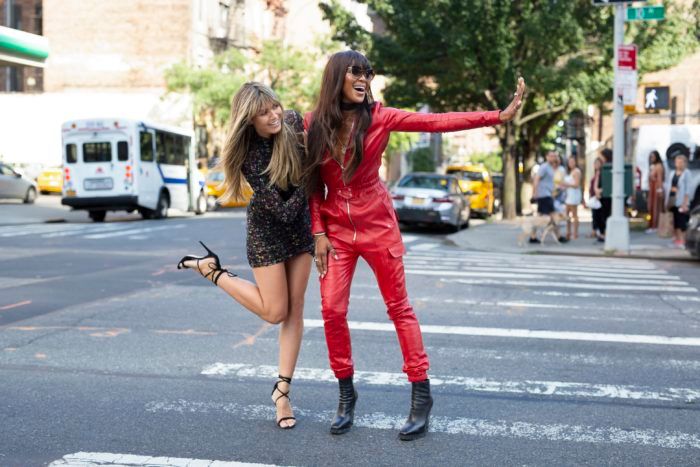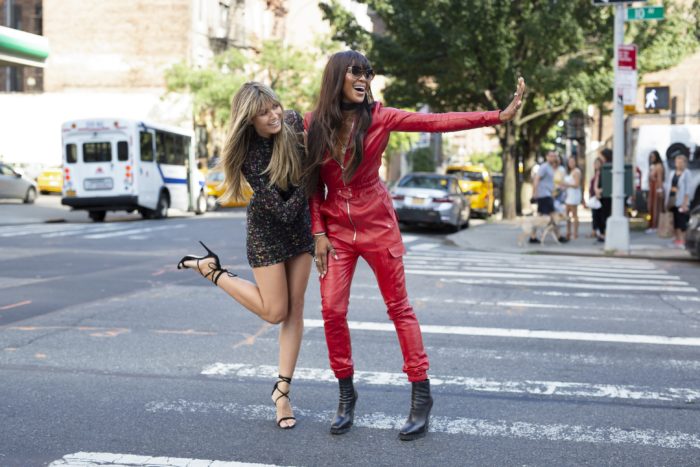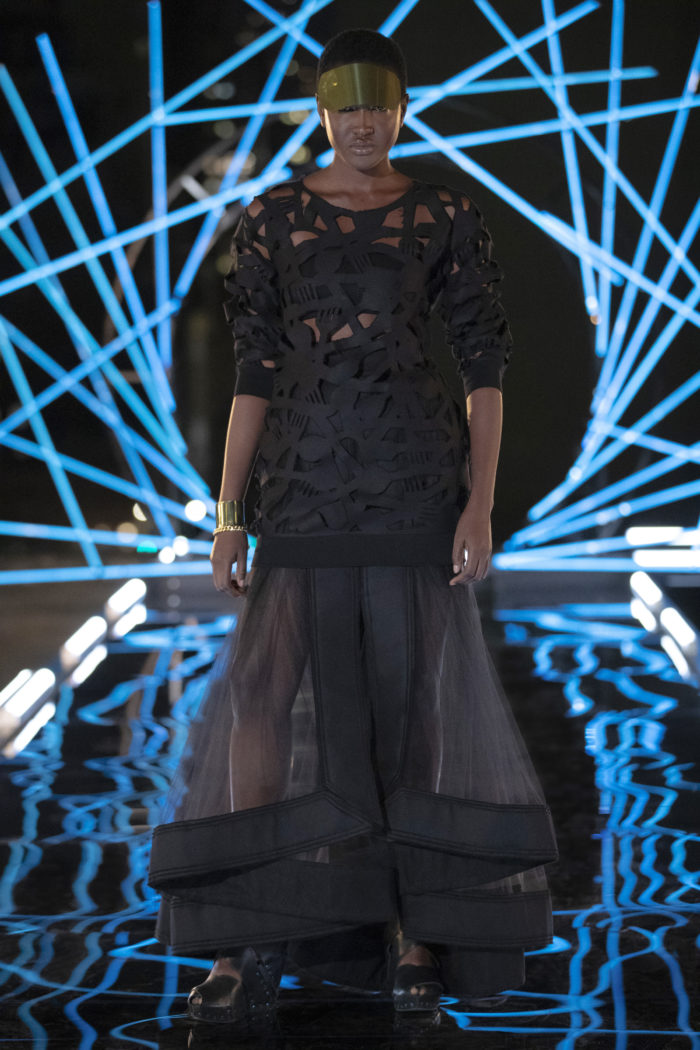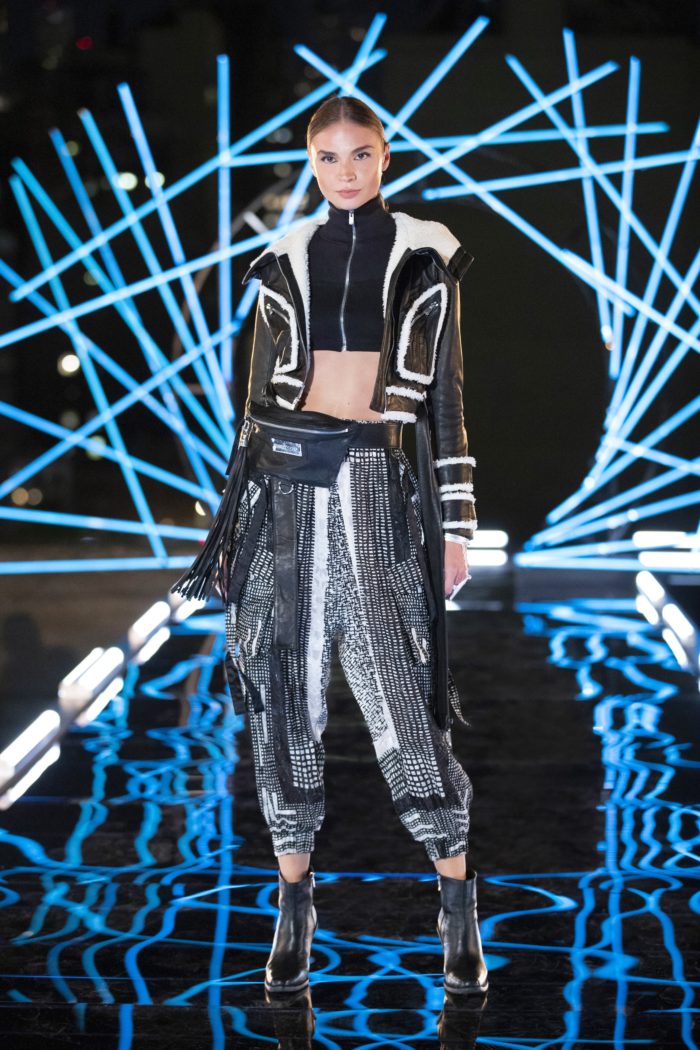
Making the Cut’s finale continued the events of Episode 9, “Pop-Up Shop.” No one had been cut or been declared a winner in that episode. The judges got to work completing their review before the final runway and before choosing “the next global brand.”

Judging the pop-up stores
Jonny Cota faced the judges first. His pop-up shop debuted his namesake brand, Jonny Cota. He called his collection “Metamorphosis.” Judge Nicole Richie said metamorphosis was the perfect word, as Jonny showed lots of growth since the beginning of the show. Judge Chiara Ferragni said she loved the accessories, and called his brand effortlessly cool.
Next was Sander Bos. He strove to make his shop more accessible while keeping his aesthetic. He offered in-house tailoring at the shop, which earned him points with the judges. Judge Naomi Campbell said his clothes seemed young, adding that he needed to be more predictable. Judge Joseph Altuzarra said the pieces were uncomplicated, and more complicated, tailored garments would have taken better advantage of the custom tailoring.
Esther Perbandt’s brand drew inspiration from three cities: Berlin, Paris, and Moscow. Her ensembles incorporated art and fashion. Heidi said it was fun to shop in her store because of the thoughtful details in every garment and accessory she offered. Naomi said she felt as if she had walked into Esther’s world. Like the other judges, Joseph Altuzarra said he loved the black rope in her retail display, but he returned to the oft repeated advice about her designs: He wanted Esther to bring additional color to her collection. Nicole pointed out that the designer may someday face the choice between becoming a big brand and sticking with her all-black aesthetic.
Jonny had the most sales and was the winner of the pop-up shop challenge. His asymmetrical black dress has already sold out on the Amazon Making the Cut store.
The judges made their decision. They cut Sander. His store was not as developed as the shops of the other two designers, they concluded. Jonny and Esther continued to the business pitch and the final runway show.
The next global brand business pitch
Both designers gave their presentations one-on-one to Christine Beauchamp, president of Amazon Fashion. I expected the judges to sit in on this, as it was pivotal to the final judging, but the stress was probably high enough for the designers without them present.
Though nervous, Esther gave a good presentation. Christine asked her if she would do print and color to reach a wider customer range, which had been a concern of the judges since early in the competition. Esther said she didn’t want to include prints and colors often, as they didn’t represent her world view. She said her clothes were designed to make a customer feel good, not just look good, so her appeal has been to make people who buy her clothes will feel powerful.
Jonny had a false start, seeming nervous at the beginning. He loosened up, though, and was able to speak easily with Christine. His presentation focused on sustainability and sustainable growth. Christine questioned him about business models and how he would handle certain situations, which he seemed to answer comfortably.
The final judging
Each designer’s collection had to include 12 to 14 looks. The designers each had one seamstress to help alter the garments for the models and complete other finishing touches. The runway was on the rooftop of the Hudson Mercantile building at Hudson Yards in New York City.
After the show, Christine reported to the judges how the designers handled the business pitches. Then Heidi called Esther and Jonny, with Tim following along for moral support.
Berlin to New York
Esther spoke with the judges first. Her collection aimed to bring Berlin spirit to New York, she explained. She said her designs may be black, but they possessed a light and passion that will never be dimmed. As expected, the judges criticized her lack of color. In her runway show, Esther included only one fabric that wasn’t black: a white-and-black check. She said she didn’t want to give up her point of view and include too much color. Her cut-out fork-and-spoon fabric was a big hit. The judges said the pieces with white really lifted up the black. They acknowledged that she took comments from them seriously without losing herself.

Strength and tenderness
It was Jonny turn to defend his collection. “Metamorphosis,” was about discovering a self he didn’t know existed, he explained. He created a lifestyle brand, including clothes, shoes, accessories, and even candles. He said he wanted to rediscover tenderness in himself and celebrate strength. The judges agreed that his colors and prints were exciting. They appreciated his styling most of the time but said his later looks appeared cluttered. However, the judges agreed his clothes had a broad appeal and all shown on the runway were wearable.

The judges voted aloud, one at a time, and the tally finally tally was 2 to 3: Jonny was declared winner of “The Next Global Brand.”
Interview with the season winner
The publicity team for the show has given me access to the winning designer for a short interview. I was excited to speak to Jonny one last time.
Since he was also the winner of the pop-up shop challenge, I started there. Why did he choose vogue dancers instead of models? “So much of my inspiration comes from underground dance culture, and music plays such a key role in my shows, in my stores, in my inspiration, in my collaborations,” he said. “So it just felt like the perfect idea to have voguers instead of models.”
His Amazon collection launches his namesake brand, but what about his original brand, Skingraft? Will it stay? “Our branding is all over the place at the moment because so much of this has been unexpected,” he said. “Skingraft will remain, it will keep doing its thing, being the little gothy stepchild of Jonny Cota. I love Skingraft, it’ll always be that . . . but my main focus will be the namesake brand Jonny Cota.”
Business pitch under stress
Moving on to the business pitch, I asked him how it compared to standing in front of the judges. “Presenting to Christine was the most nerve-wracking experience of my entire journey on Making the Cut,” he said. “I stressed about that presentation more than I stressed about any dress, any jacket, any pop-up shop in that competition . . . To be able to pitch yourself and your business and to speak clearly with a clear idea of who your brand is, I think it is one of the most crucial skills to have as the leader of a global brand.”
The presentation was just a snippet in the show, but how long was it really? “It felt like it took hours, but it was five minutes,” he said. “I prepared one that was about ten minutes, and I knew it was too long. On my way to her office, I took the middle pages of my presentation and I threw them away. I said, ‘Don’t rely on your notes, remember your intro, remember your conclusion, and just speak from the heart and look her straight in the eye, and just do it.’ ”
Fabric choices
I asked him about how he chose his fabrics, colors, and prints. “I knew I wanted to challenge myself to do print, challenge myself to do color, challenge myself to do knits, which is something we never have time to do on the show, to do knitwear,” he said. “I knew Esther would be my biggest competition, and these were all the ways I could stand out and not be compared to her.”
For his fashion show, Jonny had styled several models with rubber gloves, and I had to know how he came to that decision. “I presented to the judges that my brand is inspired by underground music culture,” he said. “I knew I wanted to accessorize and style these models so they looked otherworldly . . . but the garments themselves were actually quite wearable. So the latex gloves was kind of a nod to late-night dance culture, and it kind of just made them a little bit less clothes-on-the-rack.”
In the final minute of our interview, I asked if “the next global brand” winner would do it again. “I can’t believe I’m saying this, but I’m desperate to do it again,” he said. “Even if I wouldn’t have won, I mean it’s so much stress, the whole time you think ‘Get me out of this, I’m never going to do this again.’ But looking back on it, the pressure and stress made us do our best work. It made us put our brand into the clearest words we’d ever had to do . . . It made us push past all of our limits. That is a magical thing, and I’m thirsty for more.”
































Log in or create an account to post a comment.
Sign up Log in